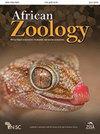坦桑尼亚湖泊生态系统中小型哺乳动物物种多样性和分布
IF 0.5
4区 生物学
Q4 ZOOLOGY
引用次数: 0
摘要
不同的驱动因素对生态系统的威胁越来越大,这些驱动因素大多与人类活动有关。这就采取了各种措施来恢复/保护这些地区的野生动物。考虑到东非大多数保护区的背景,与大型哺乳动物相比,小型哺乳动物受到的关注最少,尽管它们在维持生态系统健康方面发挥着根本作用。因此,有必要了解小型哺乳动物在任何特定生态系统中的分布情况,作为实现全面和知情管理的基线信息。我们调查了坦桑尼亚赛卢斯生态系统中小型哺乳动物的多样性和分布。使用了两种方法;捕获标记再捕获(CMR),使用70m×70m的网格,并在选定的栖息地随机放置havahart陷阱。在2018年7月至2020年6月期间,共有887只属于20个物种的个体在28224个诱捕之夜被捕获,诱捕成功率为3%。捕获的小型哺乳动物物种包括啮齿动物(91.8%)、大蠊目(3.9%)、食肉动物(2.4%)、真脂斑疹伤寒(1.6%)和灵长类动物(0.3%)。捕获数量最多的物种是阿科Acomys ngurui(36%)和嗜黄Aethomys chrysophilus(17%),而贡献最小的物种是Atilax paludinosus(0.23%)、Helogale pervula(0.23%。四种生境中分布最为广泛的物种分别为安哥拉Acomys ngurui和玫瑰Lemnicomys rosalia,而安氏Cricetomys ansorgei、Rattus Rattus、Mungos mungo和Genetta Genetta的发生率较低。在鲁菲吉河的北部地区首次报道了Grammomys selousi。在季节性河岸林中和跨季节(χ2=6,df=2,p=0.049)较高的四个栖息地之间,恩古瑞Acomys的丰度存在显著差异(χ2=12,df=3,p=0.007),雨季出现的个体更多。Sable森林栖息地的物种多样性最高(H′=2.065),而多年生河岸林/灌木丛的物种多样度最低(H′=1.506)。旱季物种多样性最高(H′=1.65),雨季物种多样性最低(H′1.445)。大多数小型哺乳动物与季节性河岸林有关,而与其他栖息地有关。总的来说,这项研究的结果表明,公园里有丰富的小型哺乳动物。因此,建议在更新《综合管理计划》(GMP)和其他计划时考虑将小型哺乳动物纳入公园管理行动。本文章由计算机程序翻译,如有差异,请以英文原文为准。
Small Mammal Species Diversity and Distribution in the Selous Ecosystem, Tanzania
Threats to ecosystems are ever increasing from different drivers mostly being linked to anthropogenic activities. This has brought about various measures to restore/protect the wildlife in these areas. Considering the background of most protected areas in East Africa, small mammals have been given least attention, compared with large mammals, although they play a fundamental role in maintaining ecosystem health. It is therefore necessary to understand how small mammals are distributed in any given ecosystem as a baseline information to enable holistic and informed management. We investigated the diversity and distribution of small mammals in the Selous ecosystem, Tanzania. Two methods were used; Capture Mark Recapture (CMR) using grids of 70 m × 70 m and random placement of havahart traps in the selected habitats. Between July 2018 and June 2020, a total of 887 individuals belonging to 20 species were captured in 28 224 trap nights with 3% trap success. The small mammal species captured consisted of rodents (91.8%), Macroscelidea (3.9%), Carnivores (2.4%) Eulipotyphla (1.6%), and Primates (0.3%). Acomys ngurui (36%) and Aethomys chrysophilus (17%) were the most captured species, whereas Atilax paludinosus (0.23%), Helogale pervula (0.23%), Rattus rattus (0.23%) and Galerella sanguinea (0.11%) were the least contributing species. Acomys ngurui and Lemniscomys rosalia were the most distributed species occurring in all four habitats, whereas Cricetomys ansorgei, Rattus rattus, Mungos mungo and Genetta genetta had low occurrence. Grammomys selousi is reported for the first time in the northern part of the Rufiji River. Acomys ngurui abundance differed significantly (χ2 = 12, df = 3, p = 0.007) between the four habitats being higher in the seasonal riverine forest and across seasons (χ2 = 6, df = 2, p = 0.049), with more individuals occurring in the wet season. The Sable Forest habitat had the highest species diversity (H′ = 2.065) and the lowest diversity (H′ = 1.506) was recorded in perennial riverine forest/thickets. The highest species diversity (H′ = 1.65) was recorded in the dry season and the lowest diversity in the wet season (H′ = 1.445). Most small mammals were associated with seasonal riverine forest than other habitats. Overall, the results from this study show that, the park is rich in small mammal fauna. Therefore, considerations in updating the General Management Plan (GMP) and other plans to include the small mammals in the park management actions is recommended.
求助全文
通过发布文献求助,成功后即可免费获取论文全文。
去求助
来源期刊

African Zoology
生物-动物学
CiteScore
2.60
自引率
9.10%
发文量
18
审稿时长
>12 weeks
期刊介绍:
African Zoology , a peer-reviewed research journal, publishes original scientific contributions and critical reviews that focus principally on African fauna in terrestrial, freshwater, and marine ecosystems. Research from other regions that advances practical and theoretical aspects of zoology will be considered. Rigorous question-driven research in all aspects of zoology will take precedence over descriptive research. The Journal publishes full-length papers, critical reviews, short communications, letters to the editors as well as book reviews. Contributions based on purely observational, descriptive or anecdotal data will not be considered.
The Journal is produced by NISC in association with the Zoological Society of South Africa (ZSSA). Acceptance of papers is the responsibility of the Editors-in-Chief in consultation with the Editors and members of the Editorial Advisory Board. All views expressed are those of the author and not necessarily those of the Editors or the Department.
 求助内容:
求助内容: 应助结果提醒方式:
应助结果提醒方式:


